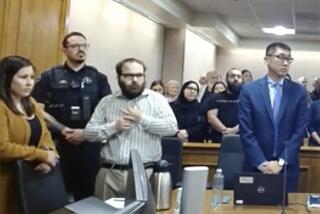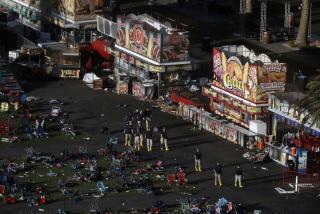Gun’s magazine shaped the pace of Colorado theater massacre
- Share via
Police think that James Holmes, suspected of killing 12 moviegoers and wounding 58 at a theater in Aurora, Colo., acted alone. But some would say the shooter had help — in the form of the three guns he brought with him into the theater.
The details of those weapons’ exact capacities and how the shooter used them are still not precisely clear, except for this one: The man that walked into a packed movie theater early Friday morning was able to do a lot of bad things very quickly.
And while investigators are still busy piecing together why they believe Holmes did what he did, others are focused on the how — namely, that the shooter had gun magazines that would have been banned under a federal gun law that lapsed in 2004.
PHOTOS: ‘Dark Knight Rises’ shooting
In recent history, many acts of spectacular gun violence have been linked not so much by the presence of assault rifles but rather by large gun magazines that allow shooters to fire longer without reloading. The current investigation will determine if this shooting continued that trend; some evidence suggests it does.
The defunct Federal Assault Weapons Ban limited most clip sizes to 10 rounds; police say the theater shooter had a .223-caliber Smith & Wesson AR-15 assault-style rifle with a drum clip that could hold up to 100 rounds and shoot as many as 60 times in a minute.
Holmes was arrested with a Glock .40-caliber pistol, which typically comes with a 15-bullet magazine, and a Remington 12-gauge shotgun. A second Glock was found in the suspect’s car.
WHO THEY WERE: Aurora movie theater victims
The gunman first used the shotgun, according to a law enforcement official quoted in the Washington Post, then pulled out the AR-15. It’s not yet known how many people were injured by which weapon, and police have said they don’t know how many rounds were fired in total.
But anecdotal evidence thus far has suggested a semi-steady stream of gunfire.
In interviews with the Los Angeles Times, witnesses in Aurora said they couldn’t immediately leave the theater because the shooter had pinned down the audience with continuous fire after an initial shot in the air, which forced many to the floor.
“Shots just started being fired -- so many,” said Tayler Trujillo, 18. “It stopped for a second, and everybody was, like, ‘Go! Go! Go!’, but then he started to fire again and then I had to go back down.”
A federal law enforcement official told the Associated Press that the shooter’s AR-15 with the large magazine jammed, forcing to him to switch to another weapon and begin firing again. Police have said they don’t know how many rounds the shooter fired.
“The ones after the break went on much longer than the first round,” Trujillo said.
“We were just laying on the ground, praying that we weren’t about to get shot,” said Tre Freeman, 18. He added of the gas the suspect had thrown: “It got to the point where our faces became numb, we couldn’t breathe because our noses were” stuffed up. “We figured our options were suffocate, get shot or run,” he said.
Trujillo, Freeman and a third witness, DeJante Harris, 19, estimated that they were in the theater for two to five minutes after the shooting began.
Much like the presence of large groups in closed spaces, large-capacity magazines are a major trait of most spectacular shootings.
In the 2011 Tucson, Ariz., attack that killed six people and nearly killed Rep. Gabrielle Giffords, police said, Jared Lee Loughner had a Glock with an expanded 30-round magazine; the carnage didn’t stop until he ran out of bullets and had to reload, at which point two men tackled him.
Norwegian officials said Anders Breivik, who has admitted to fatally shooting dozens of people at an island summer camp a year ago, had bought several 30-round clips for a Glock and his .223-caliber semiautomatic rifle. Some survivors had to escape by boat.
Witnesses said Maj. Nidal Malik Hasan, accused of killing 13 and wounding dozens more at the Ft. Hood massacre in 2009, sought out the largest-capacity handgun he could find before the shooting, also purchasing 30-round magazines. Soldiers testified later about watching their colleagues being gunned down and trying to rush Hasan during brief moments while he was reloading. He was stopped when shot by two armed policemen.
But there is one notable exception: the 2007 Virginia Tech shooter, Seung-hui Cho, who killed 30 people in 11 minutes using two pistols that had 10- and 15-round clips. A later inquest into the killings sought to determine if the outcome would have been different if the old clip ban had been in effect, limiting Cho to only 10-round clips.
“The panel concluded that 10-round magazines that were legal would have not made much difference in the incident,” the investigators concluded in their report. “Even pistols with rapid loaders could have been about as deadly in this situation.”
Even changing the law is not a sure bet to prevent large clips from being used in shootings. A 2004 Department of Justice study on the expiring 10-round-magazine regulation said the law failed to reduce the use of large magazines in shootings.
The report largely blamed a grandfather provision that allowed owners to keep large gun clips if they already owned them — which led to massive buyer demand before the ban took effect in 1994.
In the wake of the Aurora shootings, political debate over potential gun regulations has instantly polarized. On “Fox News Sunday,” host Chris Wallace asked Wisconsin Republican Sen. Ron Johnson whether banning 100-round magazines would violate the 2nd Amendment.
“I believe so,” Johnson said. “People will talk about unusually lethal weapons, I mean, that could be potentially a discussion you could have. But the fact of the matter is there are magazines, 30-round magazines that are just common all over the place. You simply can’t keep these weapons out of the hands of sick, demented individuals who want to do harm.
“And when you try and do it, you restrict our freedom. Criminals actually have to be concerned before a criminal act that maybe somebody could stop them.”
That interview drew a disgusted reaction from Dan Gross, president of the Brady Campaign to Prevent Gun Violence, who called for an open debate of all the possibilities.
“That’s the same old way we’ve been having this conversation,” Gross told the Los Angeles Times. “As long as we have politicians like that who respond to a question like that and are allowed to get away with it, that doesn’t reflect the kind of spirit I’m trying to talk about. That’s not a person who’s putting the health and safety of the American people ahead of politics.”
As for health and safety, survivor Trujillo told The Times on Sunday that the shooting was still hanging over her.
“I can’t stop thinking about it,” she said. “I can see him every time I close my eyes. The gas feeling; my lungs and my eyes watery; I have someone else’s blood on my clothes.… My days are better than my nights.”
ALSO:
Who they were: Aurora movie theater victims
Guns, ammo in Colorado theater shooting were legal
For Colorado, theater shootings bring back memories of Columbine
More to Read
Sign up for Essential California
The most important California stories and recommendations in your inbox every morning.
You may occasionally receive promotional content from the Los Angeles Times.











